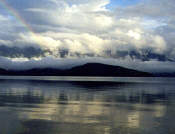It’s thousands of miles from the nearest major airport. It’s so undeveloped that it is nearly entirely roadless and mostly trail-less. You have no local contacts and do not speak the local language. Only the most expensive tours and hotels have web sites or English-language phone numbers, and you do not have that much money.
It is one of the most beautiful places on Earth. How are you going to get there?
The place is Lake Baikal. The location is South-Central Siberia. The answer is the Great Baikal Trail.
When I made the decision to travel to Siberia, I admittedly knew almost nothing about it. I could name only one city: Vladivostok.
My local library had disappointingly few books on Siberia. There was also little on the Internet, and most of that in Russian.
Siberia is so bewilderingly large – it covers a seventh of the world’s landmass – that when deciding where to go, it’s hard to decide where to begin. The idea of traveling thousands of miles from my closest acquaintance was admittedly scary.
Then I found the Great Baikal Trail (GBT).

Snake Bay
The Great Baikal Trail is an attempt to open one of the world’s greatest natural wonders to more visitors. Various statistics about Baikal are endlessly repeated: the world’s deepest lake (1 mile), the world’s oldest lake (25 million years), home to a fifth of the world’s fresh water and over 1000 endemic species, including the world’s only freshwater seal. The water is so clear you can see over 100 feet down. The ice freezes so thick in the winter that engineers once tried to run a train across it (the train sank, leaving an 11-mile trench).
What is most important, what these statistics do not say, what you must see for yourself, is that Baikal is beautiful. In summer, the landscape is blanketed in berries and flowers. Low and jagged mountains encircle the lake, reminiscent of the Swiss Alps. Baikal is still largely untouched and wild: an estimated 95% of its shores are still undeveloped.
It is so untouched that there are few trails and almost no maps. Even people born here don’t know their way around Baikal, past the couple villages on the shore.
But the Great Baikal Trail will take you there.
The Great Baikal Trail means two things. In the future, it will refer to 1200 miles of trail running a full circuit around the lake. For now, it refers to the project of building those trails.

A rainbow over Lake Baikal
Who builds these trails? I do. You can. Volunteers from around the world arrive each summer to bit by bit complete the project. Some locations are so remote that volunteers must be ferried about by chartered boat. For the less adventurous, there are projects in or near cities and regional airports.
These projects are extremely popular among Baikal locals – so popular that Great Baikal Trail leaders have ceased advertising for local volunteers. For many, it’s a chance to see parts of Baikal they could never otherwise see.
Foreigners – that is, we – are even less likely to find these places on their own. One could always hire a local guide, but that is out of many travelers’ budgets. Wandering about without so much as a map on the project, home-stays and bed-and-breakfasts during orientation. In addition, the Great Baikal Trail is a little bit more adventure than most want.
Volunteers pay for only the transportation to the meeting point: either Irkutsk or Ulan-Ude, both of which have small airports as well as stations along the Trans-Siberian railroad. The GBT provides food and lodging (that is, tents provides free visa and registration support – a rare and valuable commodity in Russia.)
Starting in the summer of 2004, the GBT is also organizing post-project tours for those who want to vacation after working on the trail (not that the trail projects are all work either; each of the two-week projects consists of several days off). Those participating will have to share the cost of the guide and food, but it remains a good deal.
I signed up for a project in the summer of 2003. Nine months later, I am still here. That in itself says enough.